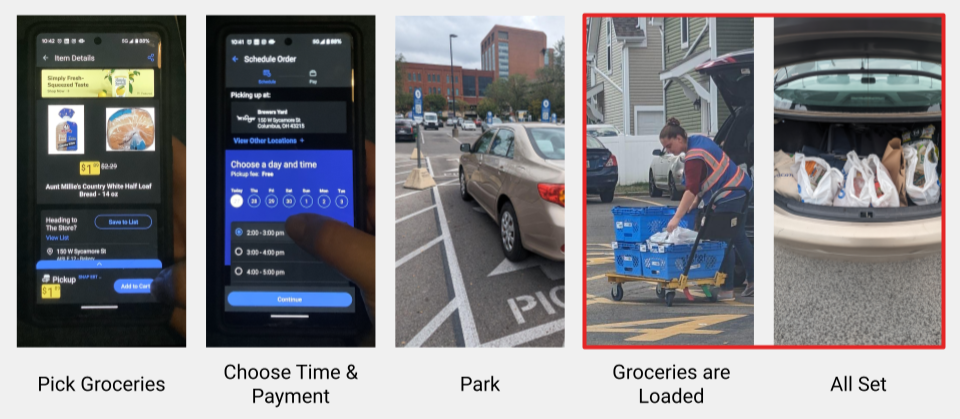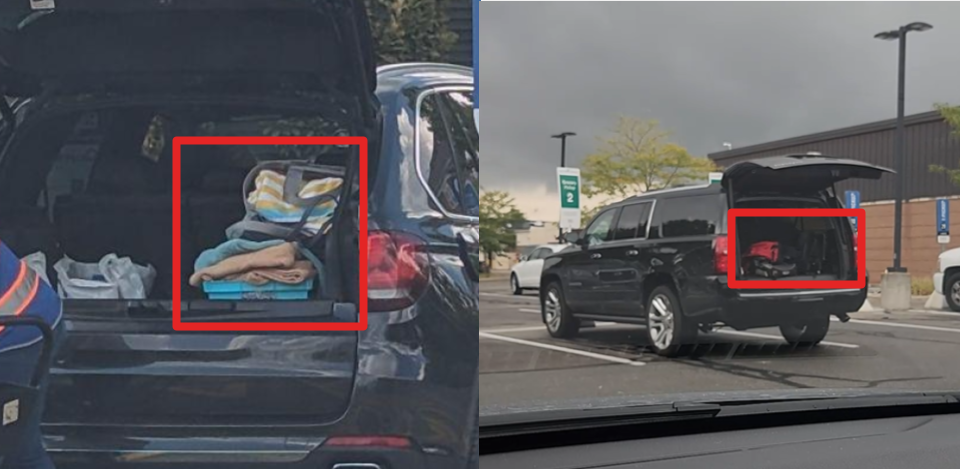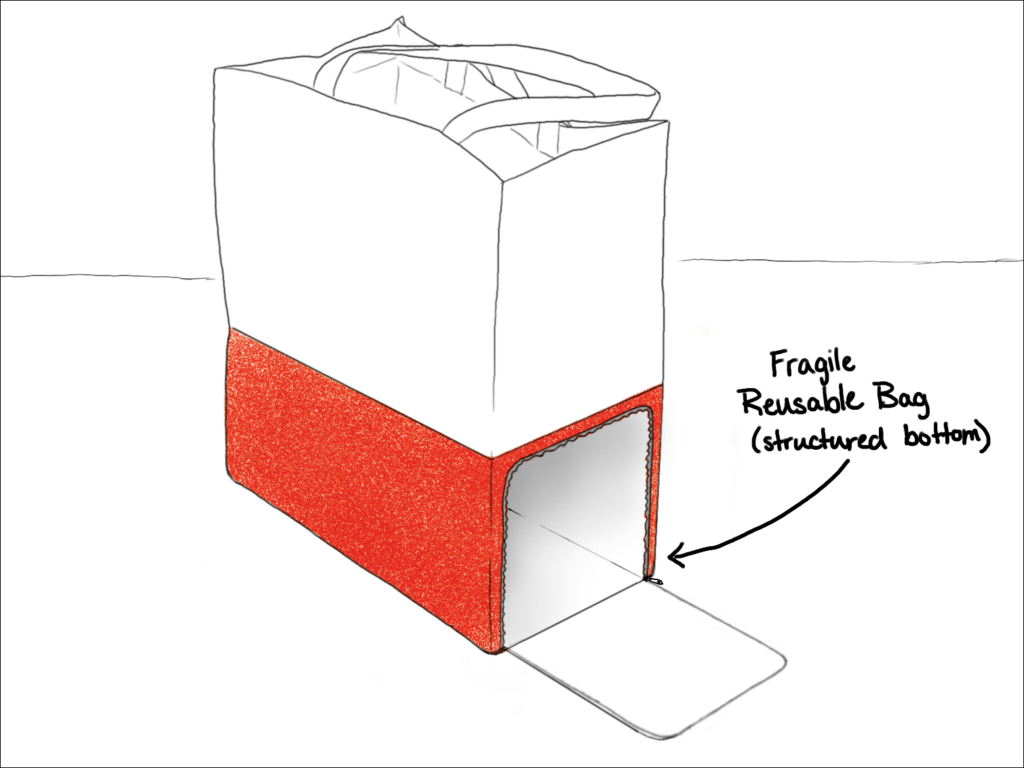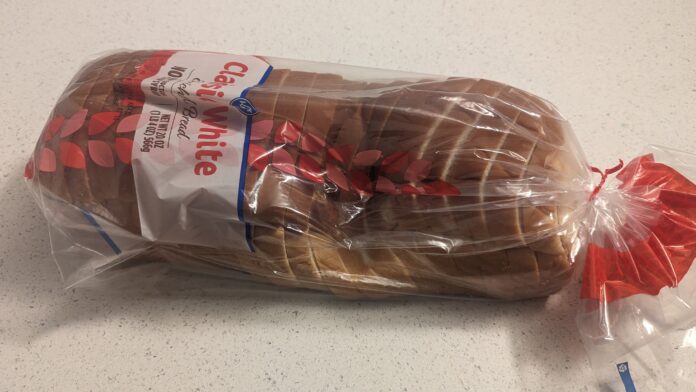On average, in 2022, Americans visited their local grocery stores 1.6 times per week (Ozbun, 2023). Hence, grocery shopping is an essential part of the American household and economy. Since grocery stores are not often within walking distance in America, an ingratiated part of the grocery shopping experience includes using a vehicle. Hence, the Honda Corporation sees an opportunity to design vehicles to support the grocery shopping experience. Specifically, with stores like Kroger seeing an 11% growth in curbside pickup orders within the first fiscal quarter of 2023, this Honda-sponsored project is focused on developing a concept to improve the user’s experience when using curbside pickup (Haleem, 2023). To begin understanding where improvements could be made, I found it important to understand what curbside grocery pickup looks like. In explaining the process and throughout the rest of the research, I will be focused on Kroger’s customers, as Honda suggested that Kroger has one of the more robust and well-developed curbside pickup systems.

For Kroger customers, curbside pickup begins by visiting Kroger’s app or website to add the items to their cart. Once they’ve added all their items to the cart, the customer chooses a one-hour time frame to pick up their groceries and a payment type to use. The time frame the customer chooses is approximately three hours after they place their order to give Kroger workers time to shop for the customer. Next, they submit the order and wait until their pickup time. The customer then heads to the store, arriving within their one-hour time frame, and parks in one of the marked curbside parking spots. Once they have parked, they notify the workers they have arrived. Then, a curbside fulfillment associate comes out to the customer’s vehicle with the customer’s groceries in a cart. After asking the customer a couple of questions, the associate places the groceries into the customer’s vehicle. Now that the groceries are loaded, the customer is off on their way to take their groceries home.
By understanding this process, it was apparent that as the designer, I have to consider how changes to the vehicle not only affect the vehicle owner but also how it would affect the curbside workers. Without the workers, there would be no curbside pickup. So, it was important to me to consider how my concept might also benefit them. I then decided to focus on the loading step in the curbside pick process, being this was where the associates interacted with the vehicle the most. Again, the first step in the loading process is when the associate comes out to the car and asks the customer some questions. In doing multiple first-hand curbside grocery pickups, I learned that the questions they often asked were, “Name on the order?”, “Do you have any additional paper coupons?” and “Where would you like your groceries to be placed in your vehicle?” The last question about where I would like my groceries to be placed took me off guard the first time I picked up my groceries. I had just assumed they always put it in the trunk.

The question of where to place the groceries in the vehicle led me to consider where most customers place their groceries in their own cars and why they place them there. To learn about this, I visited a local Kroger and observed different customers loading their groceries. Additionally, I spoke with ten customers and asked them, “Why are you placing your groceries there?” Through conversations with customers, it was revealed that each customer had a different reason for why they placed their groceries either in their front seat, back seat, or trunk. The most informative responses were, “I don’t trust my groceries not to fall over or be damaged when in the trunk; hence, I put it in the back seat,” “I place the big things in the trunk, and the fragile things in the backseat so they aren’t crushed,” and “I place them in the trunk because it’s the only space I have in the car.” My takeaways from these responses were that customers don’t trust their trunks because groceries are often knocked over or damaged while in the trunk, yet some are forced to use their trunk because it is the only open space within the vehicle.
I was concerned about these responses because, in an earlier survey with 25 fulfillment associates from across the U.S., I found that 92% of them said that if a customer doesn’t specify where to place their groceries, the associate automatically puts them into the trunk. But if customers don’t trust their groceries not to be damaged when they load their own groceries into their trunk, do they believe it will be different when curbside pickup workers are the ones loading the groceries? Through ethnographic-style research and an interview with two curbside leaders, I found two other reasons that customers might be more concerned about groceries being damaged when the curbside pickup associates load their groceries.

For ethnographic-style research, the Honda design team visited three different Kroger locations. During these various visits, we noted things like which curbside spot someone chose, how long it took the associate to load different-sized orders, and what type of vehicle the customer was driving. One thing we hadn’t tracked initially but began noticing more and more was when associates would open a customer’s trunk, they were faced with trunks that already had things within them, such as strollers, suitcases, car supplies, and blankets/towels. Since the associates are already unfamiliar with each user’s car model, additional items that customers often store in their trunks can make it even more tricky for the associate to know how to fit the groceries in. Essentially, associates have to play Tetris with customers’ groceries and the pre-stored items in the trunk, which can cause them frustration and a lack of care for the groceries, especially under time constraints.
During one of my visits to another Kroger location, I asked if I could speak with a curbside associate briefly about their experience. I was provided the opportunity to go to the back pick-up area and speak with two leaders, one who had been working in Kroger pick-up for only six months and the other who had been working pick-up for nearly six years. During our thirty-minute conversation, they both worked to explain the many different issues that could be addressed to help improve the curbside worker’s experience. While many of these issues we spoke about were ones that could more effectively be addressed by Kroger instead of Honda, they did provide me with two beneficial insights. The first insight was that associates are pushed to try and load orders from cart to car in 23 seconds (Personal Interview, 2023). Along with this first insight, they explained that by the associates being pushed to load so quickly, associates often care less about the fragility of certain groceries and more about how quickly they can get everything packed into a vehicle.
The second insight from the leaders was that groceries, at times, are damaged in this process, which comes back as complaints about the workers. Additionally, when damage occurs to groceries, it loses time, money, and potential customers for the grocery store and associates (Personal Interview, 2023). From the customer’s perspective, when groceries are loaded without consideration of the items that can be damaged, it can lead to customers being frustrated, especially when they don’t realize the damage has been done until they’ve arrived home. It can also cause the customers to lose money and the time it will take to return to a store to purchase a replacement item.
From the various research methods used, I have identified four insights:
- Customers often don’t trust their trunks to protect their groceries from falling and/or being damaged.
- Associates prefer the trunk of the vehicle even though customers have concerns about the safety of groceries within the trunk.
- A combination of time constraints & unfamiliar loading spaces can cause associates to not be considerate when loading fragile groceries.
- If groceries are damaged, it can cost the customer, associates, and grocery store time and money.
To explore how these insights might be addressed, I used conjectures as a research method to provide insight as to what features do and don’t need to be included instead of being used to consider a potential direction for the project. Here is a look at the conjectures I explored:



From all the research insights, the project objective is to design a system within the vehicle’s trunk to prevent fragile groceries from being damaged during the curbside loading process. Features that should be included are:
- Provide security (physically for the groceries, mentally for the customer).
- Be easy and efficient to use for both the customer and associate.
- Account for other items being stored in the trunk.
Sources:
Haleem, Abbas. “Kroger Grows Digital Sales 15% in Fiscal First Quarter.” Digital Commerce 360, 16 June 2023, www.digitalcommerce360.com/2023/06/15/kroger-digital-sales-grow/.
Ozbun, T. “Weekly U.S. Grocery Shopping Trips per Household.” Statista, 25 Sept. 2023, www.statista.com/statistics/251728/weekly-number-of-us-grocery-shopping-trips-per-household/.




